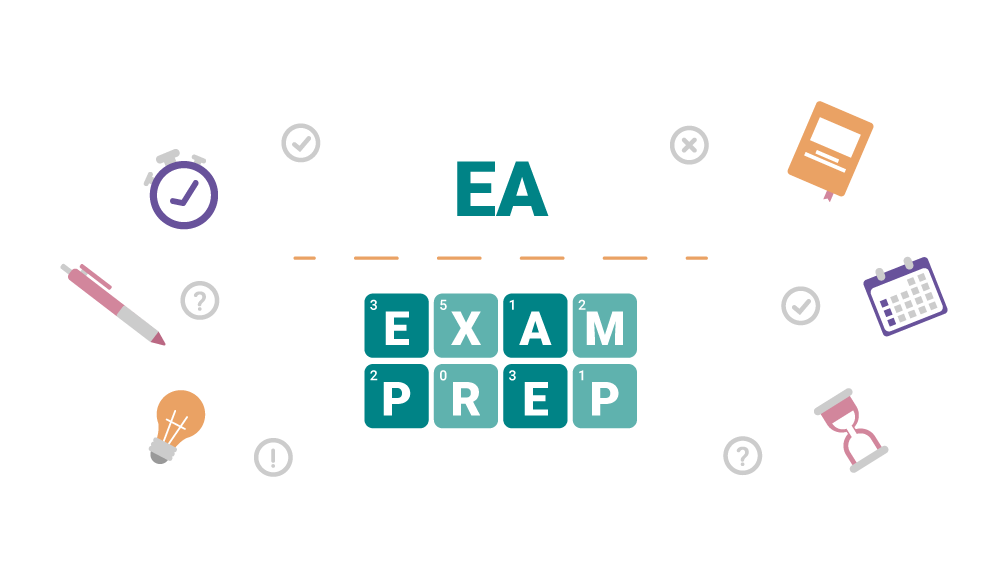In the world of finance and accounting, you’re bound to encounter plenty of acronyms. EA (Enrolled Agent) and CPA (Certified Public Accountant) are two of them.
While both professions have a wealth of knowledge around tax law and preparation, the roles are different. The job duties are unique, but each includes its own set of educational and professional qualifications.
Are you interested in pursuing either of these career paths? If so, it’s essential to understand the variations between EA vs. CPA. So today, we’re breaking down these differences for you so that you can make an informed decision for your future!

What Is An EA?
First, let’s discuss the title of an enrolled agent. How do you get it, and what does it mean?
In short, this is a professional designation given by the IRS (Internal Revenue Service). It is the highest credential that the IRS awards.
How to Become an Enrolled Agent
There is no particular educational requirement or work experience necessary to become an EA. However, any candidate who applies should have established tax knowledge.
To become an EA, a tax professional must meet one of two qualifications:
- Have experience working as a former IRS employee
- Pass a thorough, three-part IRS test on the topics of individual and business tax returns
Let’s take a closer look at the steps to follow on this career path.
Step 1: Obtain a PTIN
A PTIN (Preparer Tax Identification Number) is available through the IRS. The agency issues PTINs to all paid tax return preparers.
This will become your identification number. When you prepare tax returns for compensation in the future, this is the number that will go in the “Paid Preparer” section of the return.
Step 2: Pass the Special Enrollment Examination
The SEE (Special Enrollment Examination) is the IRS test mentioned above. You can visit the testing website beforehand to schedule your test appointment and review key information. You can even take sample test questions to gauge your knowledge!
The IRS requires all applicants to receive passing scores on all three parts of the SEE within three years to qualify. Note that if you’re a current or former IRS employee with a certain degree of technical experience, you may be exempt from taking the SEE.
Step 3: Apply For EA Enrollment
You can apply for EA enrollment directly through the IRS website. There is also a small fee required to enroll. Alternatively, you can choose to mail in your application form and fee.
The IRS explains that successful candidates should have their enrollment processed within 90 days.
Step 4: Pass the Suitability Checks
Before you can begin working as an enrolled agent, you’ll need to pass two important suitability checks. These include:
- Criminal background check
- Tax compliance check
The IRS makes sure you’ve filed all of your required tax returns with the tax compliance check and do not have any outstanding tax liabilities.
Step 5: Complete Continuing Education
Certified EAs must attend continuing education courses and renew their status every three years. You’ll also need to renew your PTIN annually.
Specific Duties and Role Requirements
In general, an enrolled agent is a tax preparer. However, this role goes a little further in that EAs can also serve as trusted tax advisors. For example, if a client needs tax compliance counseling, they can fill that role. The same applies to third parties who need written tax advice regarding specific business transactions.
If a dispute arises, an EA is authorized by the federal government to represent a taxpayer before the IRS. This professional has unlimited representation rights, which means they are free to represent any taxpayer or tax matter.
Note that this is true whether the enrolled agent prepared that taxpayer’s income tax return or not. In addition, an EA is authorized to file an appeal with any IRS office.
A few of the key roles that an EA performs include:
- Assisting clients with a range of tax matters
- Helping clients through audits
- Performing tax preparation services
- Representing clients during court hearings or conferences
Where Do They Work?
There is no designated location for enrolled agents to work.
They’re just as likely to be seen in a conventional office as in a meeting with the IRS. They also travel to client sites to meet with them face-to-face. Both big and small accounting firms will have EAs on staff, although many eventually branch off to start their own tax preparation businesses.
What Is a CPA?
Now that we’ve covered what an enrolled agent does let’s move on to a certified public accountant.
While an EA is a federal authorization, a CPA is a state-level credential. It is a designation that the State Board of Accountancy offers in each state. You can find details about all of those boards on this list.
How to Become a CPA
Each state has its list of requirements that prospective CPAs must meet before they can earn this destination. Though the specifics may vary, here is a short list of conditions that most locations require.
Step 1: Earn a Bachelor’s (or Master’s) Degree
Some states will allow college students to sit for the CPA exam. However, most will require that you wait until after graduation before taking this step.
Though most college accounting programs have only 120 total hours of coursework, almost every state requires at least 150 credit hours before you’re deemed eligible to become a certified public accountant. For this reason, most undergraduates pursue a master’s degree in a related field to make up the difference.
When checking your application, CPA reviewers will look for a bachelor’s degree in business, accounting, finance, or a related field. Specifically, they’ll be looking to see that you’ve taken core classes that align with your professional goals. For instance, many states will check your transcript to make sure you’ve earned at least 24 college credit hours in the following subjects:
- Accounting education
- Auditing
- Taxation
In addition, they’ll also ensure you’ve earned at least 30 credit hours in other business or economic-centered courses, such as:
- Business law
- Business management
- Finance
Step 2: Apply to Take the Uniform CPA Exam
Before taking the Uniform CPA exam, your state board of accountancy must review and approve your educational requirements. Then, when your application is successfully processed, you’ll receive an NTS (Notice to Schedule).
It allows you to easily schedule a time to take a certain section of the exam. In all, there are four sections, including:
- AUD (Auditing and Attestation)
- BEC (Business Environment and Concepts)
- FAR (Financial Accounting and Reporting)
- REG (Regulation)
Note that you will need a new NTS every time you take a section. Also, to receive a passing grade, you’ll need to make at least a 75 on each section. This is because they are scored on a scale from 1 to 99.
Are you looking for help? Our CPA Exam Review Courses section is filled with valuable tips, insider knowledge, and a review of some of the best study materials on the market.
Step 3: Pass the Ethics Exam
The AICPA (American Institute of Certified Public Accountants) has created a short ethics exam meant to be taken after the CPA exam. Though all states haven’t mandated it, the exam has become increasingly common.
Rather than taking your test in a designated testing center, you’ll take the materials home. There’s a study book that covers all the material, and you can take the test online.
Step 4: Complete Continuing Education and Work Experience
Before you can begin work as a certified public accountant, you’ll need to gain real-world work experience. While some states only require about six months of experience, others will require up to two years.
As you look into your state’s regulations, pay close attention to any special on-the-job training required. For instance, some states require specialized audit training, while others do not.
Step 5: Receive Your License
Once your educational and work requirements are complete, it’s time to start practicing as a licensed CPA! Once you pay your state’s license fees, your certificate will arrive in the mail.
Specific Duties and Role Requirements
A certified public accountant is a seasoned, experienced tax professional who can work in almost any aspect of the tax preparation profession. This includes assuming the following roles, among others:
- Acting as a tax counselor and advisor
- Performing audits
- Preparing tax returns
In this role, a CPA will carefully study financial records to prepare tax forms successfully. They also oversee audits and can assist with financial statements.
Where Do They Work?
Like EAs, CPAs can be found in a variety of environments. They’re a major asset to large public accounting firms but are equally valuable to a small-to-midsize operation.
You might be in an office, visiting clients, or holding review meetings with other key executives. You may also choose to go off independently, working alongside clients to break down industry jargon and help them understand their tax returns.
EA vs. CPA: Which Will You Become?
In the dispute over EA vs. CPA, there is no clear winner. Both are highly-regarded, well-educated tax professionals who have years of practical industry knowledge.





